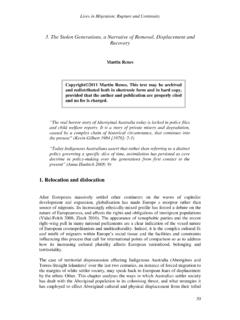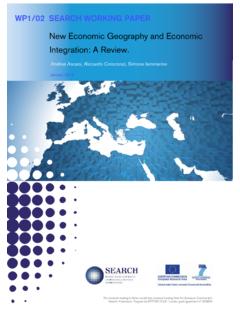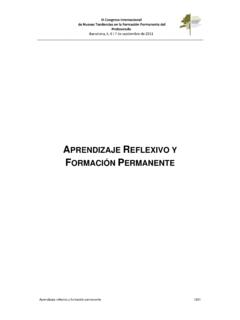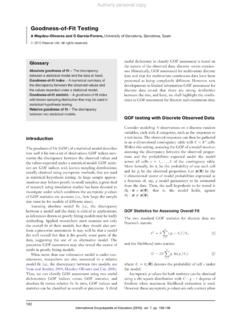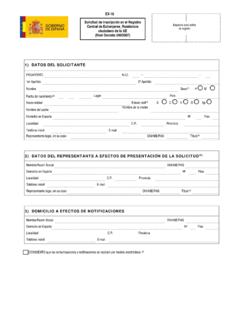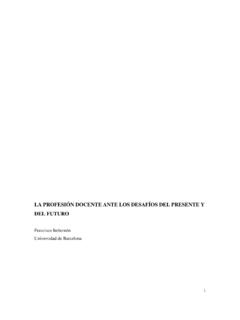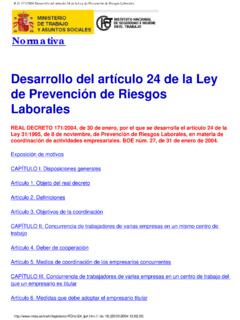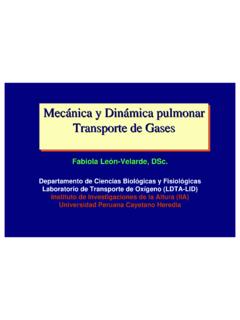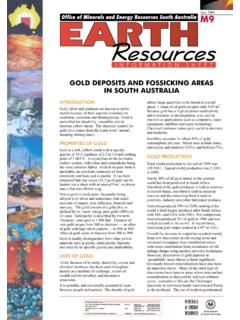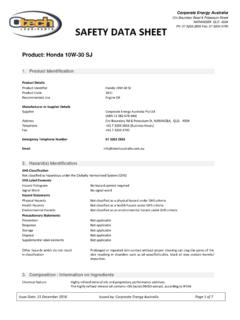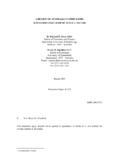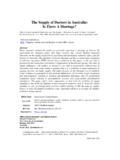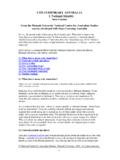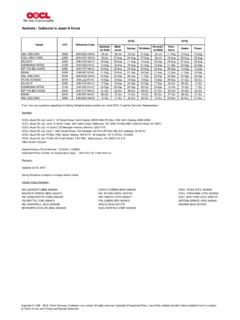Transcription of 2. The British Invasion of Australia. Convicts: Exile …
1 Lives in Migration: Rupture and Continuity 16 2. The British Invasion of australia . convicts : Exile and Dislocation Sue Ballyn On January the 26th 1788 eleven British ships under the command of Captain Arthur Phillip, first Governor of the new colony, anchored on the east coast of australia at Sydney Cove and raised the British Known as the First Fleet the ships sailed from England on the 13th of May 1787. All told, the First Fleet carried 1,500 people comprised of convicts , crew and guards. As Bateson points out: The returns of the prisoners are contradictory, but the best evidence indicates that the six convict ships sailed with 568 male and 191 female prisoners a total of 759 convicts (..) (Bateson 1985: 97). The route followed by the First Fleet can be seen on the map below:ii Following the direction of the prevailing trade winds and ocean currents, the route took the First Fleet from England to the Canary Islands, then southwards across the Atlantic to Rio de Janeiro to take on supplies,iii then south-eastward following the westerly winds across the Atlantic to the Cape and finally from there across the Indian and Southern Oceans to their final Robert Hughes gives a good idea of how many of those on board must have felt as they departed from the Cape: Before them stretched the awesome, lonely void of the Indian and Southern Oceans, and beyond that lay nothing they could imagine (1987: 82).
2 While at the Cape, the Fleet had become something of a Noah s Ark, taking on board livestock to sustain the new colony, seeds and plants. If, as they left the Cape, ahead lay nothing they could imagine , similarly they knew nothing about what the soil in the new colony would sustain, the climate, Copyright 2011 Sue Ballyn. This text may be archived and redistributed both in electronic form and in hard copy, provided that the author and publication are properly cited and no fee is charged. Lives in Migration: Rupture and Continuity 17 rainfall averages, nor even how exactly the indigenous peoples might react to their presence. It would be fair to say that sending the First Fleet out to New South Wales was a calculated risk; that the colony survived and progressed is due almost entirely to the arrival of the Second Fleet in June 1790. The arrival of these ships saved the colony from starvation and certain death.
3 From then onwards, as ships came out on a regular basis with convict labour and supplies on board, the colony flourished and the gradual exploration and settlement of the continent The reasons that led the British to invade australia were simple. The prisons in Britain had become unbearably overcrowded, a situation worsened by the refusal of America to take any more convicts after the American War of Independence in 1783. Crime rates were rising across the nation while large numbers of people were moving away from rural areas to the increasingly industrialised cities where unemployment ran high as machines replaced man power. An estimated one million people in Britain were below the bread line in 1788. Britain had looked at other geographical areas with regard to establishing penal colonies such as the west coast of Africa. This option was deemed unviable as the waters were extremely dangerous along the coast; Britain had no proper foothold in the area and it was concluded that the risk of escape was high.
4 Early contact had revealed that the indigenous populations on the coast of West Africa could indeed be bellicose. This was not a good scenario for a penal colony! On the other hand, the Indigenous Peoples of australia had barely been seen, and descriptions of those that had were deemed to be of a more friendly nature. There has long been a debate, known to some as The Botany Bay Debate , that australia was also chosen by the British with regard to the possibility of acquiring flax and timber, because of the need to protect the trade routes to China, and in order to consolidate Cook s possession of the continent for Britain. Whatever the debate, there is no doubt that the need to relocate the burgeoning convict population was the reason which prevailed over others. The British had long been experts in transporting human cargo. Transportation of felons to America had begun in the seventeenth century and although the total number of those transported is not known, it is estimated to be in the region of fifty thousand.
5 Similarly Britain had played a large lucrative role in the slave trade, abolished in 1807, though slavery itself remained legal until the Slavery Abolition Act of 1833. It seems ironic that while abolishing the slave trade and slavery, the British continued to transport convicts to australia for some time after 1833. convicts were of course judicially not slaves and transportation continued until the 1850s. The reason why transportation finally came to an end was due in part to activism in England against it and the government s and colonial authorities belief that the continued arrival of convicts would have a long-lasting detrimental effect on the new colonial society. A further side to transportation of convicts by the British is that of inter-colonial transportation such as that to the Andaman Islands, which began as a result of the Indian rebellion in 1857. A study of inter-colonial transportation within the British Empire reveals that the practice of transporting felons, dissidents and so forth to other places in the empire was widely practiced.
6 The Invasion of australia by the British , both convict and free, has tragic dimensions to it pertinent to the title of this book. On the one hand there were the convicts who were Lives in Migration: Rupture and Continuity 18 forcibly removed, uprooted and exiled from their homeland and, on the other, their presence in australia , together with that of the free migrants, brought about the displacement of the Indigenous peoples of australia . Worse than that, in time the Indigenous peoples were to find themselves exiled from their homeland and embroiled in a cultural dislocation, brought about by British and colonial intervention against their peoples, the evidence of which remains only too strongly with us today. Genocide went hand in hand with the policy of eugenics which in turn led to the forced removal of half-caste children from their families, bringing about an Exile upon Exile . Indigenous peoples were exiled from their lands and taken into missions and then their children, often the product of rape, though also of long/short standing relationships with the white man, were dragged away from their mothers and taken thousands of miles away to be educated , thereby becoming doubly exiled from their familial roots.
7 The stories that emerge from what has become known as The Stolen Generation are harrowing. When I was about twelve or thirteen years old I was taken to Moola Bulla. That's where I lost my Aboriginal ways. The Police came one day from Halls Creek when they were going on patrol to Lansdowne and found me, a half-caste child. The manager .. took me down to Fitzroy Crossing to wait for the mail truck from Derby to take me to Moola Bulla. When [the manager's wife] told my people, mum and dad, that they were taking me to Fitzroy Crossing for a trip, they told her `you make sure you bring her back'. They did not know that I would never see them again (HREOC Report 1997 quoted by Kimberley Land Council submission 345 on page 66, chapter 7). The systematic attempt to wipe out the Indigenous peoples of australia by whatever means was doomed to failure given the tenacity, courage and underestimated strength of the people themselves.
8 It has often been said that australia was built on the backs of convict slave labour. Now, we are more enlightened as to who was treated like a slave on their own land: When anybody come to pick up a worker they used to line us up and they'd make you flex your muscles. If you were big and strong they'd pick you - like a slave market. I was sent out at 11. I worked there for seven and a half years, never got paid anything, all that time. We used to bring the cattle in .. we didn't get nothing. So I had to join the army to survive (HREOC Report April 1997. Confidential evidence 549, Northern Territory: man removed in the 1930s, chapter 7). In 1997 the HREOC report of the National Inquiry into the Separation of Aboriginal and Torres Strait Islander Children from Their Families, Bringing them Home underlined the far reaching damage done by the policy of taking Aboriginal half-caste children away from their families.
9 Grief and loss are the predominant themes of this report. Tenacity and survival are also acknowledged. It is no ordinary report. Much of its subject matter is so personal and intimate that ordinarily it would not be discussed. These matters have only been discussed with the Inquiry with great difficulty and much personal distress. The suffering and the courage of those who have told their stories inspire sensitivity and respect. Lives in Migration: Rupture and Continuity 19 The histories we trace are complex and pervasive. Most significantly the actions of the past resonate in the present and will continue to do so in the future. The laws, policies and practices which separated Indigenous children from their families have contributed directly to the alienation of Indigenous societies today. For individuals, their removal as children and the abuse they experienced at the hands of the authorities or their delegates have permanently scarred their lives.
10 The harm continues in later generations, affecting their children and grandchildren (HREOC Report April 1997, chapter 1). It is difficult to write about the convicts without actually making reference to a whole nation who were deemed less than animals and held prisoners on their own land, with their sovereignty unrecognised by the invader. Exile , double Exile , internal Exile , there seems to be no name within the paradigms and terminologies of the dislocated, exiled, dispossessed that we use today, for the kind of treatment meted out to the Indigenous peoples of australia . The same is true of First Nation peoples in all countries invaded by Western Empires; one thinks of North America, Canada and South America. What shocks here is that in the case of the Indigenous peoples of australia abuse was going on under our noses in the twentieth century and still has not been truly remedied in the present.
